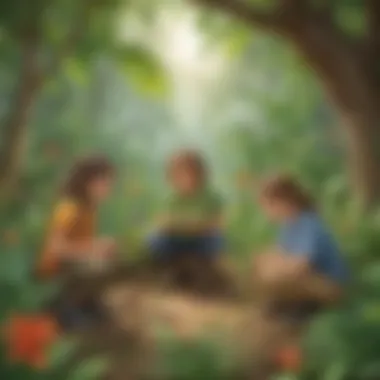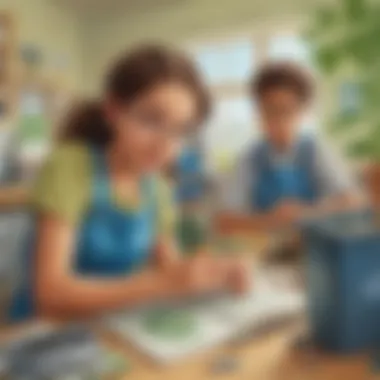Engage Curious Young Minds with Earth Day Science Activities


Science Fun Facts
Discover the Wonders of Science
Embarking on a journey to explore Earth Day through science unveils a treasure trove of scientific concepts waiting to be uncovered. Through a combination of captivating educational videos, interactive animations, and engaging learning tools, children can delve into the intricacies of our planet's ecosystem. By witnessing real-life applications of science in action, young minds are not only educated but inspired to become stewards of the environment.
Science Quiz Time
Engaging in a science quiz tailored for Earth Day encapsulates the spirit of gamified learning, providing an enthralling method to test knowledge and promote retention. Whether challenging oneself with interactive quizzes, pondering over thought-provoking multiple-choice questions, or unraveling brain teasers and puzzles, each moment adds a layer of fun to the educational journey. Through gamification, children can discover the joy of learning in a playful and interactive environment.
Science Experiment Showcase
Conducting science experiments crafted for Earth Day fosters a hands-on learning experience that encourages curiosity and experimentation. By following step-by-step instructions, referencing the materials list meticulously, and adhering to safety tips and precautions, young scientists embark on a thrilling exploration of scientific principles. Through engaging experiments, children not only learn about the planet but also develop essential skills in observation, critical thinking, and problem-solving.
Introduction to Earth Day
Earth Day signifies a pivotal occasion in our calendar, a day where the spotlight turns towards environmental consciousness and sustainability. This article embarks on a journey to explore Earth Day through activities crafted to engage and educate young minds. The essence of Earth Day lies in its ability to instill a sense of responsibility towards our planet in the hearts of children. By delving into science activities that intertwine fun with learning, we pave the way for a generation that cherishes and protects the Earth. Through hands-on experiences and engaging experiments, children can connect with nature and comprehend the significance of being stewards of our environment.
Significance of Earth Day
History of Earth Day
The inception of Earth Day marks a turning point in environmental activism. Originating in the 1970s, Earth Day emerged as a response to the pressing need for global conservation efforts. Its legacy is entrenched in the mobilization of individuals and communities towards protecting our planet's ecosystem. The history of Earth Day serves as a beacon of inspiration, igniting the passion for environmental advocacy in both young and old. This historical perspective propels us to reflect on the humble beginnings of a movement that has grown into a worldwide celebration of environmental awareness and action.
Importance of Environmental Protection
Central to Earth Day is its emphasis on the crucial role of environmental protection in sustaining life on Earth. Recognizing the interdependence between humanity and nature, Earth Day underscores the urgency of preserving our natural resources for future generations. The importance of environmental protection transcends borders and ideologies, emphasizing the collective responsibility we share towards safeguarding our planet. This ethos permeates through the activities highlighted in this article, underscoring the need for eco-consciousness in every facet of life.
Connection to Science Education


Promoting STEM Learning
At the intersection of Earth Day and science education lies a platform to promote STEM (Science, Technology, Engineering, and Mathematics) learning among young learners. By engaging in science activities themed around Earth Day, children are exposed to real-world applications of scientific concepts. Through hands-on experimentation and observation, students not only broaden their understanding of scientific principles but also cultivate a curiosity for environmental science. Promoting STEM learning within the context of Earth Day fosters a holistic approach to education, merging academic knowledge with environmental consciousness.
Fostering Environmental Consciousness
Embedded within the fabric of Earth Day is the mission to foster environmental consciousness among individuals of all ages. By integrating activities that nurture an appreciation for nature and sustainability, we cultivate a generation of environmentally aware citizens. Fostering environmental consciousness sparks a sense of duty towards preserving the Earth's delicate balance. Through educational initiatives that emphasize the interconnectedness of all living beings, children develop a deep-rooted respect for the environment and a commitment to sustainable practices. This section expounds on the transformative power of instilling environmental consciousness through science education.
Interactive Science Experiments
Interactive science experiments play a pivotal role in educating young minds about environmental concepts and sustainability. These activities not only foster a love for science but also instill a sense of responsibility towards the planet. By engaging in hands-on experiments, children can grasp complex scientific principles in a fun and interactive manner. The interactive nature of these experiments allows kids to witness scientific phenomena firsthand, igniting their curiosity and promoting critical thinking skills.
Water Conservation Activities
Rainwater Harvesting Model
Rainwater harvesting is a crucial method for conserving water resources. The rainwater harvesting model offers a practical way to demonstrate how rainwater can be collected and utilized for various purposes. Children learn about the significance of preserving water through this hands-on activity. The key characteristic of the rainwater harvesting model lies in its simplicity and effectiveness in water conservation. By showcasing the process of collecting rainwater and its benefits, this experiment emphasizes the importance of sustainable water management. Participants can understand the advantages of utilizing rainwater as an eco-friendly alternative to traditional water sources.
Water Filtration Experiment
The water filtration experiment teaches children about the importance of clean water and the methods used to purify it. By constructing a water filtration system, kids explore the mechanisms of water treatment and purification. This experiment highlights the key characteristic of water filtration, which is to remove impurities and contaminants from water, ensuring its safety for consumption. The unique feature of this experiment is its hands-on approach to showcasing how filtration works, making complex water treatment processes more understandable to young learners. Participants gain insight into the advantages of clean water and the significance of preserving water quality.
Renewable Energy Demonstrations
Solar Oven Construction
Solar oven construction introduces children to the concept of harnessing solar energy for cooking. By building a solar oven, kids learn about renewable energy sources and their practical applications. The key characteristic of solar oven construction is its focus on utilizing sunlight to generate heat for cooking. This experiment emphasizes the efficiency and sustainability of solar power, encouraging participants to explore alternative energy solutions. The unique feature of this activity is its hands-on construction process, allowing children to witness solar energy conversion in action. Participants gain an understanding of the advantages of solar energy and its role in reducing carbon emissions.
Wind Turbine Simulation


The wind turbine simulation educates children about wind power and its role in generating electricity. By simulating a wind turbine, kids explore the dynamics of wind energy conversion. This experiment highlights the key characteristic of wind turbines, which is to capture wind energy and convert it into electrical power. The unique feature of this simulation is its interactive nature, providing children with a visual representation of renewable energy production. Participants discover the advantages of wind power as a sustainable energy source and gain insights into the benefits of clean electricity generation.
Plant Biology Projects
Seed Germination Study
The seed germination study offers children a hands-on opportunity to observe the growth of plants from seed to sprout. By conducting this study, kids learn about the biological processes involved in plant germination. The key characteristic of a seed germination study is its focus on understanding the conditions required for seed growth and development. Participants explore the unique feature of seeds sprouting and the subsequent growth stages, providing valuable insights into plant life cycles. This activity allows children to appreciate the advantages of planting seeds and nurturing plant growth, fostering a deeper connection to nature.
Photosynthesis Simulation
The photosynthesis simulation demonstrates how plants convert light energy into chemical energy for growth. By simulating photosynthesis, children explore the vital process that sustains plant life. The key characteristic of photosynthesis simulation is its emphasis on the role of sunlight in plant metabolism. This experiment showcases the unique feature of chlorophyll in capturing light energy and converting it into glucose. Participants gain an understanding of the advantages of photosynthesis in producing oxygen and food for plants, highlighting the importance of this process for ecosystem sustainability.
Educational Resources for Earth Day
Earth Day is a crucial moment to instill environmental consciousness in young minds. Educational resources play a pivotal role in this process by providing avenues for interactive and informative learning experiences. In this article, we delve into the importance of including educational resources as part of Earth Day celebrations. These resources not only serve to educate children about the planet but also spark curiosity and promote a sense of responsibility towards the environment. By focusing on specific elements such as online learning platforms, printable activity sheets, and environmental awareness videos, we aim to offer a comprehensive guide to enhancing children's understanding of Earth Day and its significance. ### ne Learning Platforms ### Onl earning platforms have revolutionized the way children engage with educational content, making it accessible and interactive. Virtual Field Trips, one of the key elements of online platforms, provide students with immersive experiences that transcend physical boundaries. Through virtual realities and interactive simulations, students can explore ecosystems, climates, and conservation efforts, enhancing their understanding of environmental issues. These trips offer a unique opportunity for experiential learning, allowing children to witness firsthand the impact of human activities on the planet. On the other hand, Interactive Eco-Games offer a playful yet educational approach to environmental topics. These games incorporate challenges and quizzes that test children's knowledge of sustainability, conservation, and renewable energy. By gamifying learning, interactive eco-games make the educational process engaging and entertaining, motivating children to delve deeper into environmental concepts. Despite the advantages of online learning platforms, it is essential to monitor screen time and ensure a balance between digital and physical activities to promote holistic development. ### Printab tivity Sheets ### Printable a ty sheets, such as Coloring Pages of Ecosystems and Crossword Puzzles on Sustainability, provide tactile learning experiences that cater to diverse learning styles. Coloring Pages of Ecosystems allow children to express their creativity while learning about different habitats, species, and natural cycles. These sheets not only enhance artistic skills but also reinforce scientific knowledge in a fun and interactive manner. Crossword Puzzles on Sustainability, on the other hand, challenge children to think critically about environmental concepts and terms. By solving puzzles related to recycling, energy conservation, and biodiversity, children can reinforce their understanding of key sustainability principles. These activity sheets serve as valuable resources for parents and educators, facilitating meaningful discussions about environmental issues and fostering a sense of responsibility towards the planet. However, it is important to select activities that are age-appropriate and align with children's educational needs and interests. ### Environmental A ess Videos ### Environmental aware videos, such as Documentaries on Climate Change and Animated Short Films on Recycling, offer visual narratives that inspire and educate young audiences. Documentaries on Climate Change present scientific evidence and real-world examples of climate impacts, provoking reflection and discussion on the urgent need for environmental action. Through the powerful storytelling and expert interviews, these documentaries shed light on complex environmental issues in an accessible and engaging way. Animated Short Films on Recycling, on the other hand, simplify environmental messages through captivating animations and relatable characters. By showcasing recycling processes, waste management practices, and the importance of conservation, these films communicate important lessons in a format that resonates with children. While environmental awareness videos can be effective tools for raising consciousness about sustainability, it is essential to facilitate open dialogues post-viewing to address children's questions and emotions about environmental challenges. Each video should be accompanied by age-appropriate guidance and supplementary resources to deepen children's comprehension and inspire environmental stewardship.
Promoting Green Practices:
Promoting Green Practices holds paramount significance within the realm of Earth Day science activities for young minds. It effectively instills essential values of environmental sustainability and responsibility in the minds of the budding generation. By focusing on eco-conscious actions such as upcycling, recycling, and energy conservation, children can grasp the tangible impact of their behaviors on the planet's health and longevity. Promoting Green Practices not only cultivates a sense of stewardship towards nature but also nurtures a proactive approach to tackling pressing environmental issues.
DIY Upcycling Projects:
Reuse and Recycle Crafts:
Among the various facets of DIY Upcycling Projects, Reuse and Recycle Crafts emerge as a pivotal avenue for channeling creativity while promoting sustainability. This hands-on activity encourages children to repurpose everyday items like plastic bottles, cardboard, and old newspapers into new and innovative creations, fostering a culture of waste reduction and resourcefulness. The key characteristic of Reuse and Recycle Crafts lies in its ability to transform trash into treasure, stimulating creative thinking and environmental consciousness simultaneously. Participants can experience the satisfaction of turning discarded materials into functional or decorative items, highlighting the versatility and practicality of upcycling in the context of Earth Day celebrations.
Repurposed Material Art:
Within the spectrum of DIY Upcycling Projects, Repurposed Material Art stands out as a captivating way to blend artistic expression with sustainable practices. This form of artistry involves utilizing salvaged materials such as bottle caps, yarn scraps, or fabric remnants to craft visually appealing masterpieces, giving a new lease of life to objects that would have otherwise ended up in landfills. The unique feature of Repurposed Material Art lies in its ability to inspire ingenuity and resourceful thinking, turning overlooked items into stunning artwork while emphasizing the importance of mindful consumption and waste reduction. Participants can explore different textures, colors, and shapes, learning to appreciate the beauty in repurposed materials and contributing to the promotion of sustainable art practices.


Community Garden Initiatives:
Planting Events:
Community Garden Initiatives encompass a diverse range of impactful activities, with Planting Events holding a special place in fostering connection with nature and communal engagement. Through guided planting sessions, children can actively participate in sowing seeds, nurturing plants, and observing the growth process firsthand, cultivating a deeper appreciation for the environment and the food we consume. The key characteristic of Planting Events lies in their ability to offer a hands-on experience that transcends theoretical knowledge, allowing participants to witness the wonders of nature's life cycle up close. By engaging in planting events, individuals develop a sense of responsibility towards nurturing plant life and understanding the interconnectedness between humans and the natural world.
Vegetable Patch Creation:
With a focus on sustainable food production and self-reliance, Vegetable Patch Creation emerges as a fundamental aspect of Community Garden Initiatives. Establishing a vegetable patch provides children with practical lessons in gardening, from preparing the soil to choosing suitable crops and maintaining plant health. The key characteristic of Vegetable Patch Creation lies in its capacity to empower young participants to grow their own food, promoting healthy eating habits and environmental sustainability. By tending to a vegetable patch, individuals learn about the nutritional value of fresh produce, the importance of soil health, and the satisfaction of harvesting homegrown vegetables, fostering a deeper connection to the earth and sustainable food practices.
Sustainable Living Workshops:
Composting Demonstrations:
Within the domain of Sustainable Living Workshops, Composting Demonstrations play a vital role in educating young minds about organic waste management and soil enrichment. Participants engage in hands-on composting activities, learning about the decomposition process, the benefits of compost for soil health, and the significance of reducing food waste. The key characteristic of Composting Demonstrations lies in their ability to bridge the gap between waste generation and resource conservation, highlighting the cyclical nature of organic matter and its role in sustainable agriculture. By participating in composting demonstrations, children gain practical skills in environmental stewardship, promoting a circular approach to managing household waste and nurturing soil biodiversity.
Energy Saving Tips:
Empowering individuals to adopt energy-efficient practices, Energy Saving Tips within Sustainable Living Workshops offer actionable strategies for reducing carbon footprint and promoting eco-friendly behaviors. By exploring simple yet effective ways to conserve energy, such as turning off lights when not in use, unplugging electronic devices, or optimizing heating and cooling systems, participants can contribute towards mitigating climate change and preserving natural resources. The key characteristic of Energy Saving Tips lies in their accessibility and immediate impact on household energy consumption, encouraging small but meaningful lifestyle changes that collectively lead to a greener and more sustainable future. By implementing energy-saving tips, children learn about the importance of energy conservation, financial savings, and environmental stewardship, promoting a culture of sustainability within their homes and communities.
Conclusion
In the realm of Earth Day celebrations, the conclusion serves as a pivotal moment to reflect on the essence of our actions. Embracing environmental stewardship signifies a commitment to safeguarding our planet for future generations through conscious and sustainable practices. It encapsulates the core ethos of Earth Day, emphasizing the intersection of science, education, and environmental responsibility. By encouraging young minds to engage in activities that promote holistic wellbeing, we instill values of conservation and appreciation for the natural world.
Encouraging Environmental Stewardship
Continuing Science Exploration
Exploring the facet of Continuing Science Exploration unveils a profound avenue for nurturing children's curiosity and scientific acumen. This component advocates for a persistent engagement with scientific inquiry, propelling young learners to delve deeper into environmental studies. Its fundamental role lies in fostering a sense of intellectual curiosity and analytical thinking within children, equipping them with a solid foundation in scientific principles.
Amidst the myriad options for exploration, Continuing Science Exploration stands out due to its dynamic nature, offering a hands-on approach to learning about Earth's ecosystems. Its interactivity amplifies the educational experience, enabling students to grasp complex concepts with ease. Despite encountering challenges, the experimental nature of Continuing Science Exploration instills resilience and problem-solving skills in children, preparing them for future academic pursuits.
Commitment to Earth's Wellbeing
The aspect of Commitment to Earth's Wellbeing epitomizes the essence of environmental stewardship, underlining the enduring responsibility we hold towards the planet. By acknowledging our interconnectedness with nature, this commitment advocates for sustainable practices that mitigate ecological harm and promote biodiversity. At the crux of its significance lies the acknowledgment of Earth as a shared resource, necessitating collective efforts to preserve its fragile balance.
A defining characteristic of Commitment to Earth's Wellbeing is its focus on proactive initiatives that transcend individual actions. It underscores the power of collective impact in effecting positive change, emphasizing the role of communities in driving environmental progress. By fostering a sense of ownership and accountability for Earth's health, this commitment cultivates a heightened sense of environmental consciousness among individuals, empowering them to advocate for sustainable policies and practices.







